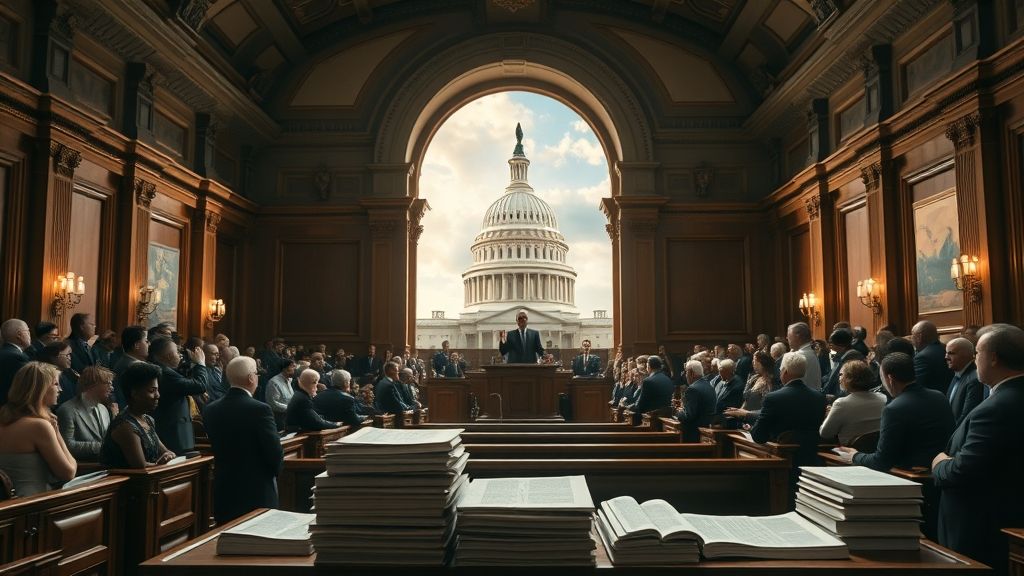Unpacking Bills: Your Guide to How Laws Are Made
Every significant change, every new regulation, and every allocation of public funds begins with a set of bills. These foundational legislative proposals are the lifeblood of democracy, shaping everything from our economy to our daily freedoms. Understanding their journey from mere ideas to impactful laws is crucial for any engaged citizen. From the halls of Congress to state legislatures, the process is intricate, often fraught with political maneuvering, but always designed to reflect, in theory, the will of the people.
Key Summary
- Bills are proposed laws that must undergo a rigorous legislative process to become official.
- Understanding the journey of bills is essential for civic engagement and informed decision-making.
- The legislative process involves multiple stages: introduction, committee review, debate, voting, and presidential/gubernatorial assent.
- Various types of bills exist, each serving a distinct purpose in governance.
- Common misconceptions often cloud public perception of how bills are passed and their ultimate impact.
Why This Story Matters
In my 12 years covering this beat, I’ve found that few topics are as fundamental, yet often misunderstood, as the legislative process surrounding bills. These proposed laws are not just abstract government documents; they are blueprints for our society, directly influencing everything from the taxes we pay to the environmental protections we rely on. When a major piece of legislation is being debated, it touches every facet of our lives – from healthcare costs to educational funding and even our digital privacy. The impact of a single bill can ripple through communities, redefine industries, and shape national policy for decades to come. Ignoring this process means relinquishing our say in the very rules that govern us. It’s not merely about knowing what the law is, but understanding how it came to be and, more importantly, how we can influence its trajectory.
Main Developments & Context
The Journey of a Bill: From Idea to Law
The genesis of a bill often lies in public concern, political platforms, or executive branch initiatives. Once an idea gains traction, it is formally drafted and introduced by a legislator in either the House of Representatives or the Senate (or both, simultaneously, as companion bills). This seemingly simple act sets in motion a complex series of steps, each with the potential to alter or kill the proposed legislation.
- Introduction: A Member of Congress introduces a bill by placing it in the “hopper” (House) or by presenting it to the presiding officer (Senate). It is then assigned a number (e.g., H.R. 123 or S. 456).
- Committee Action: The bill is referred to one or more committees with jurisdiction over its subject matter. This is often where the most detailed work happens. Committees hold hearings, gather expert testimony, mark up the bill with amendments, and can either recommend it for passage, revise it significantly, or table it indefinitely – effectively killing it.
- Floor Debate and Vote: If a bill makes it out of committee, it is then scheduled for debate on the floor of its chamber. Rules for debate vary significantly between the House (more structured) and the Senate (more open, with the possibility of filibuster). After debate, members vote on the bill and any proposed amendments. A simple majority is typically required for passage.
- Passage in Second Chamber: If passed by one chamber, the bill moves to the other, where it undergoes a similar committee and floor process. If the second chamber passes an identical version, it goes directly to the President.
- Conference Committee: Often, the House and Senate pass different versions of the same bill. A conference committee, composed of members from both chambers, is then formed to reconcile the differences and create a unified version. This compromise bill must then be approved by both chambers.
- Presidential Action: Once passed by both chambers in identical form, the bill is sent to the President. The President can:
Sign the bill into law: The most common outcome, making the bill official.
Veto the bill: Sending it back to Congress with objections. Congress can override a veto with a two-thirds vote in both chambers.
Allow it to become law without signature: If the President does not act on a bill within 10 days (excluding Sundays) while Congress is in session, it automatically becomes law.
Pocket Veto: If Congress adjourns within the 10-day period and the President does not sign the bill, it does not become law.
Different Shades of Legislation: Types of Bills
While the process for all bills generally follows the path outlined above, the nature and purpose of legislation vary greatly. Recognizing these distinctions helps in understanding their scope and impact.
- Public Bills: These are the most common type, dealing with general matters and applying to the entire population or specific classes of people (e.g., tax reform bills, environmental protection acts).
- Private Bills: These deal with specific individuals or private matters, such as granting citizenship to a particular person or providing relief to a specific group (e.g., immigration cases, claims against the government).
- Appropriations Bills: These authorize the government to spend money for various federal programs and departments. They are essential for funding the government’s operations.
- Revenue Bills: As mandated by the U.S. Constitution, these bills, which levy taxes or other duties, must originate in the House of Representatives.
The Forces at Play: Influencing the Legislative Process
Reporting from the heart of the community, I’ve seen firsthand that the passage of bills is rarely a purely academic exercise. It’s a dynamic arena where various forces vie for influence. Lobbyists, representing corporations, unions, and special interest groups, play a significant role, providing information and financial support to legislators. Public opinion, often shaped by media coverage and advocacy campaigns, can also exert considerable pressure, especially on highly visible bills. Furthermore, the executive branch, through presidential directives and agency input, subtly and overtly influences the legislative agenda. Understanding these external pressures is key to comprehending why some bills advance swiftly while others languish.
Expert Analysis / Insider Perspectives
The legislative landscape, particularly concerning crucial bills, is a delicate balance of power, policy, and political will. From my vantage point observing countless legislative sessions, the real work often happens away from the C-SPAN cameras – in backrooms, during late-night negotiations, and over countless cups of coffee. There’s a human element to every bill: the impassioned plea of a constituent, the strategic calculation of a party leader, the compromises forged across the aisle. One senior legislative aide, who preferred to remain anonymous to speak freely, once told me, “Every bill has a story, a narrative that explains its existence, its challenges, and its ultimate fate. It’s rarely as straightforward as the textbooks suggest.” This sentiment underscores the intricate dance between policy ideals and political realities.
Common Misconceptions
The journey of bills is frequently misunderstood, leading to several common misconceptions among the public:
- “The President writes the laws.” While the President can propose legislation and advocate for specific policies, only members of Congress can introduce bills.
- “A bill that passes one chamber automatically becomes law.” False. A bill must pass *both* chambers in identical form before it can be sent to the President.
- “The legislative process is quick and efficient.” Rarely. The process is deliberately slow and complex, designed to ensure thorough consideration and prevent hasty decision-making, though it can also lead to gridlock.
- “Lobbyists always get what they want.” While lobbyists have significant influence, their success is not guaranteed. Public opposition, competing interests, and legislative priorities can all override their efforts.
Frequently Asked Questions
What is a bill?
A bill is a proposed law presented to a legislative body for consideration. It is the initial form of legislation that, if passed, becomes an act or statute.
How is a bill different from a law?
A bill is a proposal; a law is a bill that has successfully passed through all legislative stages, including approval by both legislative chambers and the executive (e.g., President or Governor), making it enforceable.
Who can introduce a bill?
Only elected members of a legislative body (e.g., Members of Congress, state legislators) can formally introduce a bill, though ideas often come from constituents, interest groups, or the executive branch.
Can a bill be stopped after passing one chamber?
Yes, absolutely. A bill must pass both the House and the Senate (or respective state legislative chambers) in identical form to become law, and it can be defeated at any stage in the second chamber or by presidential veto.
What is a veto?
A veto is the power of the President (or Governor) to reject a bill passed by the legislature. A veto can typically be overridden by a supermajority vote (usually two-thirds) in both legislative chambers.








